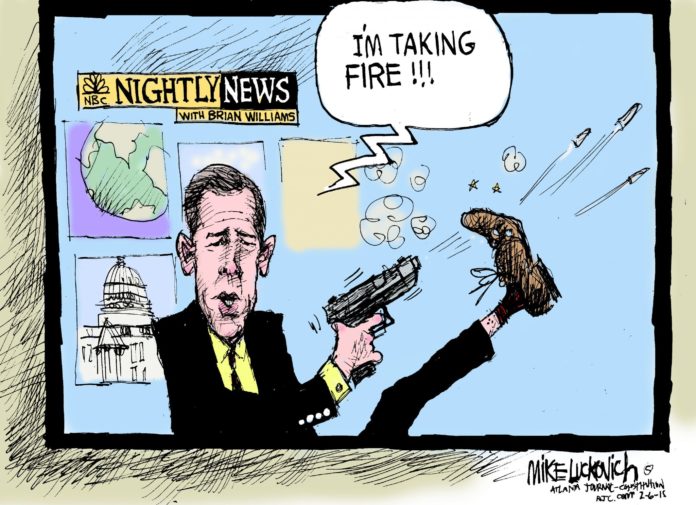BY GENE POLICINSKI
You can’t make this kind of thing up.
On the very day America’s top real news anchor gets suspended for telling fake news, the nation’s leading anchor of a mock news program tells us he’s leaving his job – really.
Brian Williams got tossed Tuesday from NBC Nightly News for six months without pay for misstating the facts about facing enemy fire in a helicopter in Iraq in 2003.
Jon Stewart – within hours – tossed out to an unsuspecting audience that he’s leaving Comedy Central’s satirical news program The Daily Show sometime within months.
For those concerned about good journalism and the future of a free press, neither announcement is a laughing matter.
Williams’ aggrandizing misstatements, apparently made over multiple years about a wartime experience in 2003 in Iraq, give unnecessary fuel to those who attack all journalists as biased, uncaring or inept. And Stewart’s departure will leave a void among those who use humor to hold newsmakers and news providers accountable, a task the nation’s founders would have approved of – and chortled over.
Even pundits such as The New York Times’ media and culture writer David Carr [who died suddenly Thursday night] joked that perhaps the pair should just switch jobs. No less a figure than Fox News commentator Bill O’Reilly, the Los Angeles Times said, initially blamed Williams’ pursuit of beyond-the-news celebrity – appearing on The Late Show with David Letterman, as the example – for the NBC anchor’s admitted tall tale about being in a helicopter with U.S. forces that was struck by a rocket-propelled grenade.
O’Reilly said Williams’s blunder “could be attributed to the pressure to ‘be cool’ in front of a hip talk-show audience that doesn’t watch the news” … where “truth becomes secondary in such situations.”
“Truth” – or as Stewart’s colleague, Stephen Colbert, called it in 2005, “Truthiness” – really wasn’t secondary to The Daily Show, or as polls showed, to its viewers, either. It just came wrapped around entertainment engineered by one of the sharpest wits of our era.
Stewart’s approach gleefully skewed politicians, pundits and others – often through the use of video footage that showed in a clear way inconsistencies or politically expedient shifts in viewpoint.
The news media was not spared Stewart’s barbs, from cable TV financial gurus or commentators who gave grossly erroneous or self-serving advice to consumers, to the hosts of talk shows that he saw as meaningless or even harmful to real public discussion.
Most famously, as a guest on the former CNN program Crossfire that he had characterized as contributing to the “dumbing down” of America, Stewart told the two hosts that “you’re partisan – what do you call it – hacks.” When the show was canceled some months later, a CNN news executive said he agreed “wholeheartedly with Jon Stewart’s premise.”
On the Williams scandal, Stewart mockingly contrasted news media huffiness about the anchor’s damaged credibility with examples of repeated media failure to challenge the Bush Administration’s later-discredited claims leading up to the Iraq War about “weapons of mass destruction” and nuclear development – challenging viewers to consider which was the worse error.
Stewart’s impact on the news media was even the subject of academic study. In 2010, in the Journal of Mass Media Ethics, a report cited multiple examples of how his show has held the news media accountable for shallow, excessive or erroneous reports.
At various times, The Daily Show was rated a significant source of news for younger Americans; and in a 2011 online poll by Time magazine, Stewart ranked highest as “most trusted” when posed against actual news anchors – including Brian Williams.
Williams was considered the most-visible and likely the most-influential of the current crop of anchors – before he was challenged first over the helicopter-RPG story and then his accounts of other news events. Of the many hurdles that Williams faces in restoring his journalistic standing is that the incident comes in a period of ever-greater danger around the world to journalists genuinely risking their lives to report news and information.
The Newseum’s Journalists Memorial in Washington, DC, bears the names of thousands who have died since 1837 in pursuit of news. It’s rededicated annually to those who died in the previous year, as a reminder that newsgathering and reporting is a dangerous and sometimes fatal task. In 2014, the Committee to Protect Journalists listed 61 killed – and already lists 15 more dead in the first six weeks of this year.
A walk through the soaring glass and metal memorial, with all those names etched on multiple panels, makes Williams’ faked account of risking his life while on a news assignment all the more tragic, mystifying and profoundly disappointing.
– Gene Policinski is chief operating officer of the Newseum Institute and senior vice president of the Institute’s First Amendment Center. He can be reached at gpolicinski@newseum.org.







